February is the start to the garden busy season. In many regions, indoor and outdoor sowing and planting will begin this month. Gardeners in warm regions already have seed and young plants in the ground. In cold regions, where is snow on the ground, February is still the time for making plans and preparing for spring.
Here is a zone-by-zone to-do list for February. You’ll find planting and garden care tips for trees and shrubs, perennials, annuals, bulbs, the lawn, and container gardens for your region.
Use the USDA Hardiness Zone Map below to check your zone if you are unsure.
If you are unsure when the last frost in spring happens where you live–and when the first frost in autumn comes. Go to this post: Average Last and First Frost Dates for Cities, States, and Countries. The months between the last frost in spring and the first frost in autumn is the natural growing season for your region.
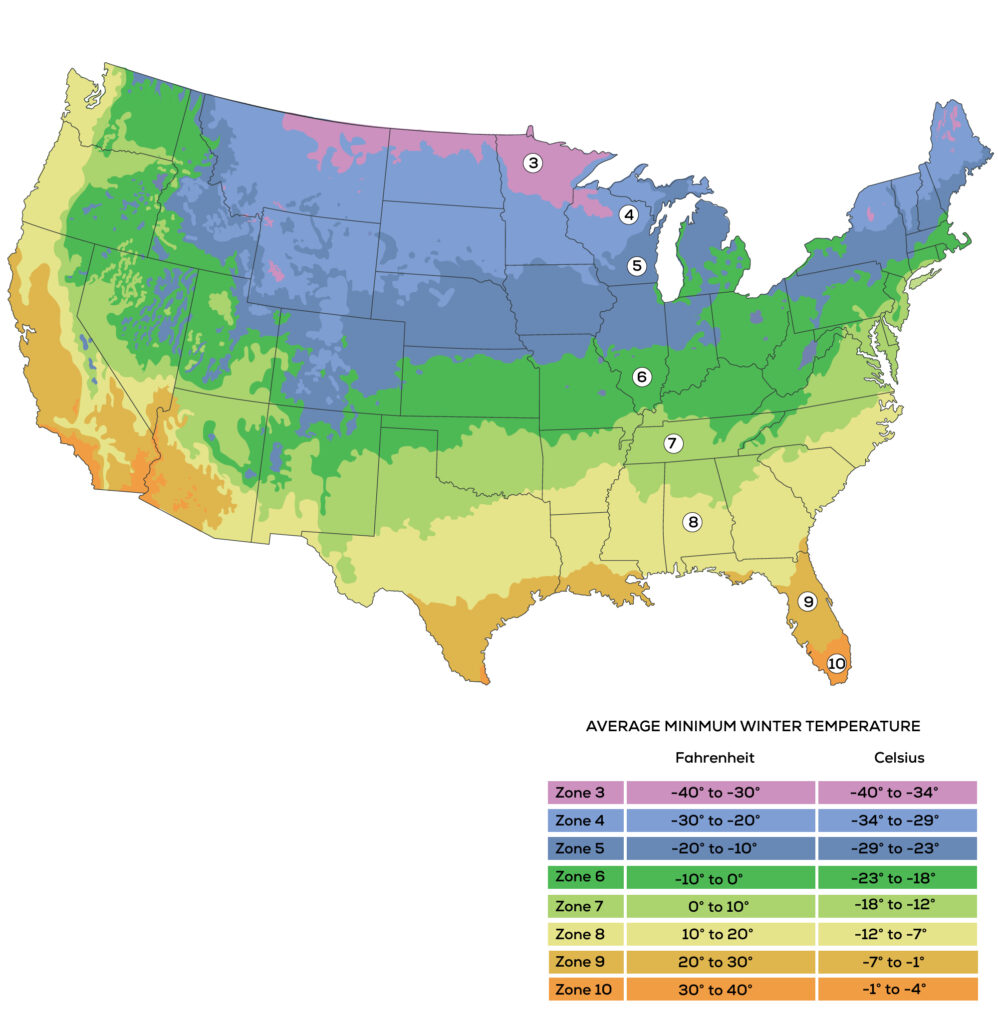
Tips for Zones 10-11:
Trees and Shrubs: Plant balled-and-burlapped and container-grown shrubs and trees. Install supports for recently planted trees. Transplant shrubs that need to be moved. Prune trees and shrubs removing dead, broken, and diseased wood. Fertilize established and newly planted trees, shrubs, and vines. Wait one to two months after planting to fertilizer citrus. Water deeply during dry weather. Layer shrubs. Sow seeds of woody plants indoors or outdoors. Take softwood cuttings of woody plants for rooting.
Roses: Complete rose pruning started in January. Fertilize established roses when new growth begins. Transplant roses that need to be moved. Plant bare-root roses. Plant container-grown roses. Water deeply once a week during dry spells. Install trellis or fence support for climbing roses.
Lawns and Ground Covers: Lightly fertilize lawns and ground covers as they begin to grow, if not done last month. Aerate the lawn; de-thatch if necessary. Trim shaggy ground covers if not done last month. Water lawns if the weather is dry. Prepare seedbeds for new lawns that are to be sown; sow grass seed, lay sod, or plant plugs. Plant groundcovers.
Perennials: Thin overcrowded perennial flower beds. Sow perennial seeds indoors and outdoors. Plant spring bloomers. Fertilize established plants when they begin to grow. Dig and divide summer and autumn bloomers. Root chrysanthemum cuttings. Cut back ornamental grasses to the point where you see new growth. Weed and clean up beds and borders.
Bulbs: Start planting summer bulbs outdoors; plant gladiolus in successions two weeks apart. Fertilize spring bulbs as shoots appear; sprinkle wood ashes if slugs are a problem. Plant forced bulbs outdoors. Plant tender bulbs such as gloriosa lily, tuberose, and cannas; keep them in the cold frame until next month.
Annuals: Deadhead winter annuals; remove worn-out plants. Plant out hardy annuals; sow sweet peas; set out pansies. Sow bachelor’s buttons, snapdragons, stock, nasturtiums, and California poppies outdoors. Late in the month begin to harden-off tender annuals in a cold frame. Pinch back plants growing indoors or in a cold frame. Deadhead winter annuals; remove worn-out plants.
Container Gardens: Plant hardy annuals in containers; water as needed. Prune container shrubs while dormant.

Tips for Zone 9:
Trees and Shrubs: Finish planting bare-root trees and shrubs while still dormant. Plant balled-and-burlapped and container-grown stock. Install supports for recently planted trees. Fertilize established and newly planted trees, shrubs, and vines. Fertilize rhododendrons and azaleas after bloom is over. Wait one to two months after planting to fertilizer citrus. Prune shade trees and summer- and autumn-flowering trees. Prune summer- and autumn-blooming shrubs. Prune and train vines. Remove winter mulches. Water deeply during dry weather. Layer shrubs. Take softwood cutting of woody plants for rooting.
Roses: Begin pruning by mid-month. Prune bush roses by cutting out frost-damaged, dead, or crossing stems. Fertilize established roses when new growth begins. Transplant any roses that need to be moved. Plant bare-root and container-grown roses. Install trellis or fence support for climbing roses. Water deeply once a week during dry spells.
Lawns and Ground Covers: Lightly fertilize lawns and ground covers as they begin to grow, if not done last month. Aerate lawn; de-thatch if necessary. Prepare seedbed for new lawns. Trim or prune messy-looking ground covers. Divide ground covers and perennial ornamental grasses. Plant and transplant ground covers. Plant ornamental grasses. Water lawns if the weather is dry.
Perennials: Plant spring-blooming perennials. Sow perennial seeds indoors and outdoors. Fertilize established plants when they begin to grow. Dig and divide summer and autumn perennial bloomers. Thin out overgrown plantings. Weed and clean up beds and borders.
Bulbs: Start tuberous begonias, caladiums, dahlias indoors in bright light to plant out next month. Fertilize spring bulbs as shoots appear. Sprinkle wood ashes around spring bulbs if slugs are a problem. Lift, divide, and replace crowded clumps of snowdrops as soon as the flowers fade.
Annuals: Deadhead winter annuals; remove worn-out plants. Plant out hardy annuals; sow sweet peas; set out pansies. Sow Brachycome, Centaurea, Clarkia, Convolvulus, and Eschscholzia. Indoors start seeds of flowers that are slow to develop such as lisianthus, wax begonias, petunias, and geraniums. Plant Iceland poppies, calendulas, foxglove, and primroses in flowerbeds. Late in the month begin to harden-off tender annuals in a cold frame. Pinch back plants growing indoors or in a cold frame. Set out snail and slug bait and protect seedlings from birds.
Container Gardens: Plant hardy annuals in containers; water as needed. Prune container shrubs while dormant.
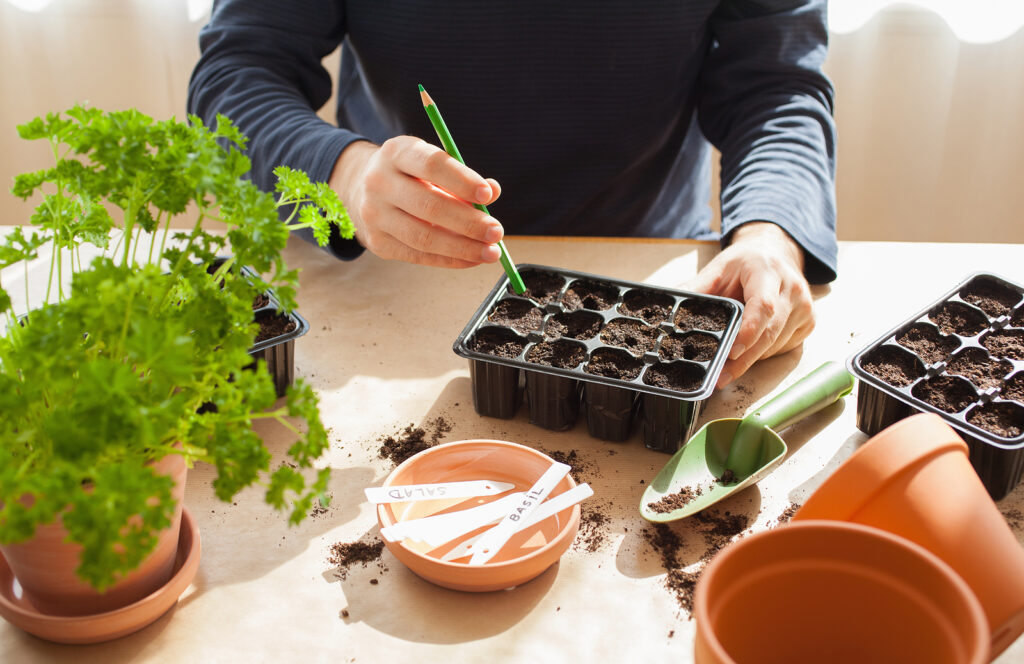
Tips for Zone 8:
General: In cold regions, the weather can still be icy in late winter and early spring, but in mild climates, you can make a start on many outdoor jobs. If sowing or planting outdoors, bear in mind that the soil temperature, as well as air temperature, is important. Few seeds will germinate if the soil temperature is below 45°F (7°C), so use a soil thermometer to check before you sow.
Trees and Shrubs: Plant bare-root stock while still dormant. Plant balled-and-burlapped and container-grown stock. Deciduous shrubs and hedges can be planted during mild weather. Continue pruning dormant trees and shrubs. Prune and train vines. Prune hydrangeas and fuchsias. Thin out weak shoots from climbing plants. Fertilize established and newly planted trees, shrubs, vines, and evergreens. Fertilize newly planted stock. Remove winter mulches. Wait one to two months after planting to fertilizer citrus. Water deeply during dry weather. Layer shrubs as soon as the soil can be worked.
Roses: Plant bare-root roses while still dormant if the ground is not wet. Prune bush roses before new growth begins; cut out any frost-damaged, dead, or crossing stems. Prune out one-third of the oldest, woodiest growth to encourage new shoots. Do not prune climbing roses that are non-repeat flowering types. Fertilizer established plants when new growth appears.
Lawns and Ground Covers: Try to keep off the grass if it is frozen since damage encourages the onset of diseases. Lightly fertilizer lawns and ground covers as they begin to grow. Aerate lawn; de-thatch if necessary. Trim messy looking ground covers. Cut back ornamental grasses to new growth. Start seeds of ground covers and ornamental grasses indoors.
Perennials: Sow perennials indoors or in a cold frame. Begin removing winter mulches. Weed and clean up beds and borders. Fork over beds for spring plants and sowing unless manured in autumn, rake in a top dressing of bone meals or a general fertilizer. Lift, divide, and replant established or oversized herbaceous perennials, discarding any weak plants. Dig and divide summer and autumn blooming perennials. Prune summer-flowering clematis by cutting them back hard when they start to grow. Fertilize established plants when they begin to grow.
Bulbs: Lift, divide, and replace crowded clumps of snowdrops as soon as the flowers have faded. Plant summer-flowering bulbs if the ground is not frozen or waterlogged. Plant gladioli, anemones, lilies, and Ranunculus in mild areas. Start tuberous begonias, caladiums, dahlias indoors in bright light to plant out next month. Fertilize spring bulbs as shoots appear. Sprinkle wood ashes around spring bulbs if slugs are a problem.
Annuals: Weed and clean the garden beds where pansies and other hardy spring flowers will soon be planted. Direct-sow or transplant out hardy annuals; sow sweet peas; set out pansies. Sow tender summer annuals indoors to plant out after the last frost. Plant alyssum, hollyhocks, edging lobelia, rocket larkspurs, and Canterbury bells. Take cuttings of geraniums, wax begonias, coleus to start new plants for this year’s garden. Pinch back plants started indoors last month. Plan and design flowerbeds, and other uses for annuals, including window boxes and containers.
Container Gardens: Check container plants moved indoors for winter. Ensure that the spaces beneath tubs and pots are free of leaves and other debris that may impede drainage. Protect slightly tender, early-flowering shrubs in containers, such as magnolias and rhododendrons if severe frost threatens. Prune shrubs in containers while dormant. Disinfect clay pots by soaking in a bleach solution. Inventory and restock supplies if not done last month.
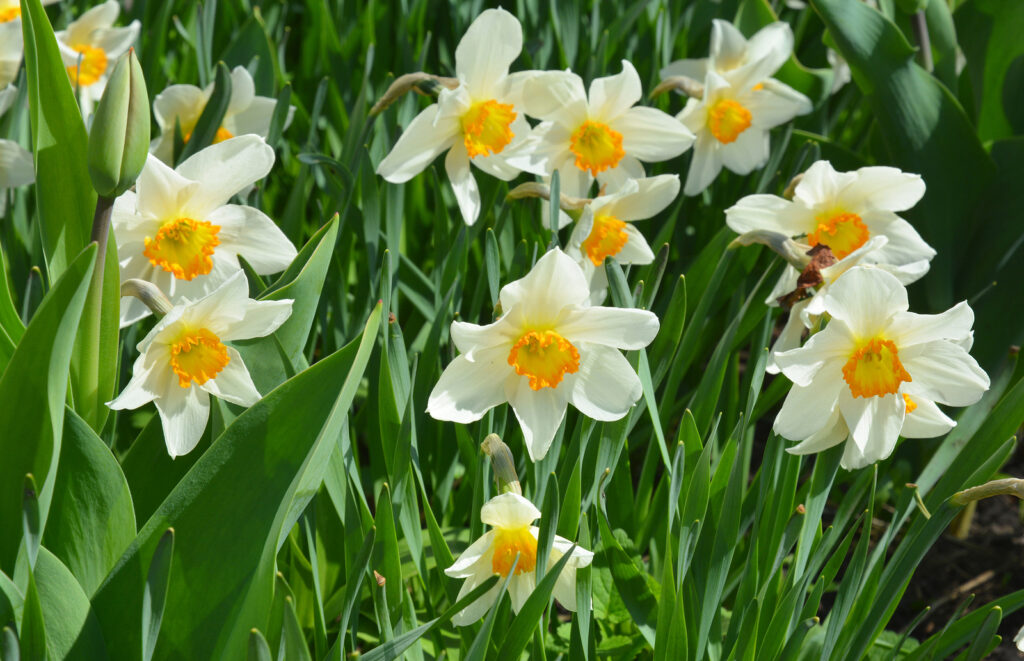
Tips for Zone 7:
General: In cold regions, the weather can still be icy in late winter and early spring, but in mild climates, you can make a start on many outdoor jobs. If sowing or planting outdoors, bear in mind that the soil temperature, as well as air temperature, is important. Few seeds will germinate if the soil temperature is below 45°F (7°C), so use a soil thermometer to check before you sow.
Trees and Shrubs: Knock heavy snow off conifers if the branches start to bend under the weight. Check supports on climbers and young trees; reset if heaved by frost. Plant bare-root stock. Prune shade trees. Prune dormant trees. Do not prune spring bloomers except to remove weak and damaged branches. Prepare planting holes as early as possible for planting trees. During dry spells, water fall-planted trees and shrubs and shallow rooters such as azaleas. Check tree guards. Check supports on climbers and young trees; reset if heaved by frost.
Roses: Order roses for early spring planting if you have not already done so. Check supports for climbers; replace any detached canes. Prune bush roses before new growth begins. Late in the month, prune hybrid tea roses hard, but give shrub roses only a light trim. Spray roses with dormant oil spray when the temperature goes above 45 degrees—but while plants are still dormant. Check supports for climbers; replace any detached canes.
Lawns and Ground Covers: Avoid walking on frozen lawns. Use sand or ashes on icy walks and driveways—salt damages lawns and other plants. Get lawnmower ready for spring: clean and sharpen the blade. As soon as the ground is thawed, fill in bare and low spots on the lawn and spread seed. Press into soil ground cover plants that have heaved from the ground. Start seeds of ground covers and ornamental grasses indoors.
Perennials: Finish ordering plants. Sow perennials indoors or in a cold frame for transplanting out in spring. If the weather is mild, begin removing winter mulches. Check mulches in beds and borders. Weed and clean up beds and borders. If the weather is still cold, check for frost heaving; replace or cover any exposed roots. Protect winter-flowering hellebores from being splashed with mud by covering them with cloches. Sow perennials indoors or in a cold frame. Cut back ornamental grasses if not done last month.
Bulbs: Order summer-flowering bulbs. Check summer bulbs, corms, and tubers in store. Divide clumps of dahlia roots. Start dahlia tubers in damp peat moss. Start tuberous begonias indoors in bright light. New shoots that have started on these may be rooted like any other cutting. Fertilize early spring bulbs as shoots appear. Sprinkle wood ashes around spring bulbs if slugs are a problem. Pot tender bulbs for indoor spring bloom. Carefully fork over the surface soil in flowerbeds containing spring-flowering bulbs to break up compaction and to deter the growth of algae, moss, and weeds.
Annuals: Prepare and fertilize the soil of flowerbeds as soon as the ground can be worked. Improve the soil of flowerbeds, if necessary. Pinch back plants started indoors last month. Sow tender annual seeds that require 6 to 8 weeks or more indoors. Sow hardy annuals outdoors; sow sweet peas in rich soil. Sow indoors dwarf dahlias, nierembergia, verbena, stock, lobelia, and bedding begonias. Cut back geraniums stored indoors over winter. Take cuttings of geraniums, wax begonias, coleus to start new plants for this year’s garden. Study seed catalogs and order seeds. Check germination requirements of seeds ordered.
Container Gardens: Finish cleaning pots and containers. Disinfect clay pots by soaking them in a bleach solution. Inventory and restock supplies if not done last month. Check tender container plants move indoors for winter. Inventory supplies, if not done last month.
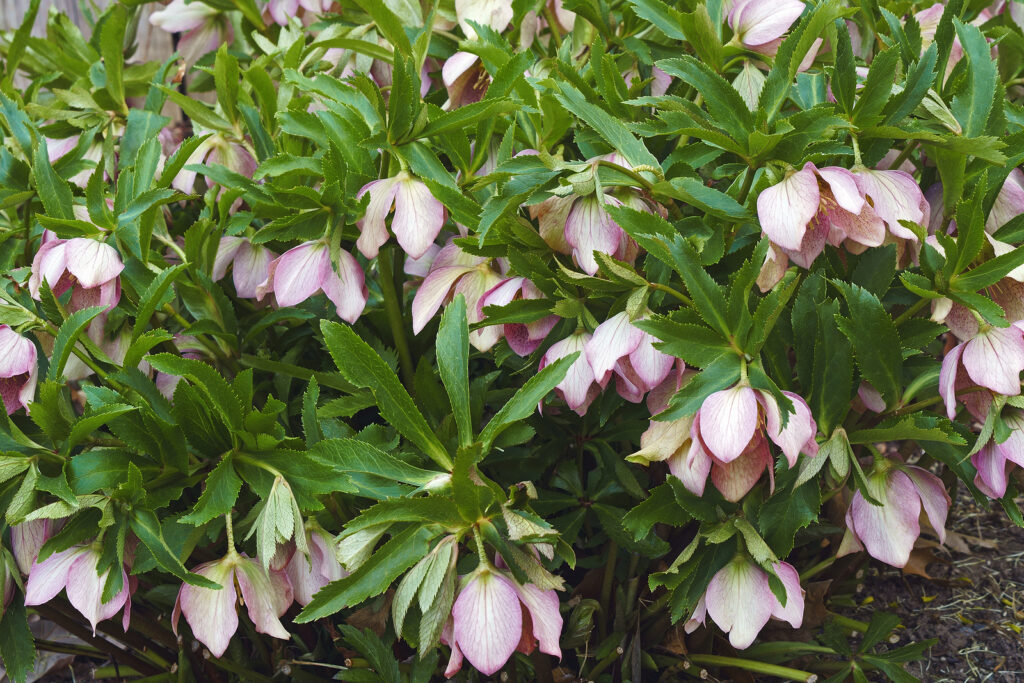
Tips for Zone 6:
General: Plan and design the garden. Has your seed order arrived? Have seeds been ordered? If not, do it now. The same advice applies to perennial plants for setting out in March. Prepare garden beds as soon as the ground can be worked.
Trees and Shrubs: Brush heavy snow off branches to prevent the wind from snapping them. Prune dormant trees. Spray evergreens with antidesiccant. Remove snow and ice from evergreens after every snowfall. Replace mulch as needed. Check supports for recently planted trees. Continue pruning; do not prune spring bloomers except to remove weak and damaged branches. During dry spells, pull aside the mulch and water fall-planted trees and shrubs, and shallow-rooters such as azaleas. Check tree guards. Check supports on young trees and climbers; reset if heaved by frost. Apply dormant oil sprays on mild days. Prepare planting holes as early as possible for planting shrubs and trees.
Roses: Order roses for early spring planting if you have not already done so. Check supports for climbers; replace any detached canes. Prune bush roses before new growth begins.
Lawns and Ground Covers: Use sand or ashes on icy walks and driveways—salt damages lawns and other plants. Avoid walking on frozen grass with no snow cover. Replace mulch as needed. Spray broad-leaved evergreen ground covers with antidesiccant. Press into soil any plants that have heaved from the ground. Water plants if the soil is dry and the temperature is above freezing. Start seeds of ground covers and ornamental grasses indoors, As soon as the ground is thawed, fill in bare and low spots on lawn and seed. Distribute pre-emergence crabgrass killer plus plant food on lawns. Get lawnmower ready for spring; clean, sharpen the blade.
Perennials: Order perennials for spring planting. Sow seeds indoors for transplanting out in spring. Check mulches in beds and borders. Check for frost heaving; replace or cover any exposed roots. Finish drawing or revising plans for beds and borders. Study seed and planting catalogs for new ideas for spring. Sharpen and repair garden tools.
Bulbs: Start tuberous begonias indoors in bright light. Check summer bulbs stored indoors. Divide clumps of dahlia roots. Fertilize early spring bulbs as shoots appear. Sprinkle wood ashes around spring bulbs if slugs are a problem. Order summer-flowering bulbs. Start dahlia tubers in damp peat moss. Start tuberous begonia, caladium, and gloxinia tubers by planting, bud side up, in flats of damp peat moss or fir bark. Tops should remain exposed. Pot up calla lilies. Set out after the last frost.
Annuals: Sow slow-growing annuals indoors. Cut back geraniums stored indoors over winter. Take cuttings of geraniums, wax begonias, coleus to start new plants for this year’s garden. Pinch back plants started indoors last month. Start slow-growing flowers such as garden verbena, stocks, wallflowers, and ageratum indoors.
Container Gardens: Finish cleaning pots and containers. Disinfect clay pots by soaking them in a bleach solution. Check tender container plants moved indoors for winter.
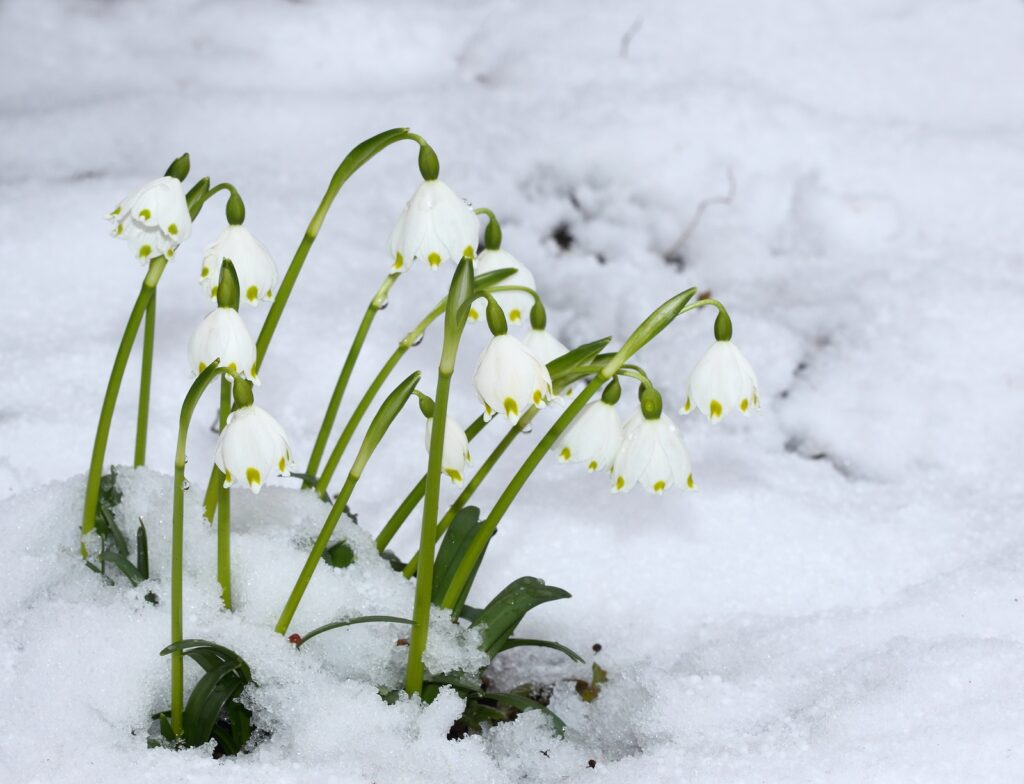
Tips for Zones 3-5:
General Tips: Study online and mail order plant catalogs. Plan and design this year’s garden. Get seeds and plants ordered including roses. Study your landscape and note areas which are wind-swept, areas that lie in deep snow, and areas that are deeply or partially shaded or in full sun. This knowledge will help you when planting time arrives.
Trees and Shrubs: Order nursery stock for early spring planting. Continue dormant pruning. When temperatures go above 40°F (4.4°C), check for overwintering pests and apply oil sprays. Check tree guards. Check climbers to be sure they are still fastened to their supports. Remove snow and ice from evergreens.
Roses: Oder roses for early spring planting. Check supports for climbers; replace any detached canes.
Lawns and Ground Covers: Use sand or ashes on icy walks and driveways—salt damages lawns and other plants. Avoid walking on frozen grass with no snow cover. Get lawnmower ready for spring; clean, sharpen the blade.
Perennials: Order perennials for spring planting. Sow seeds indoors for transplanting out in spring. Check mulches in beds and borders. Check for frost heaving after a thaw; replace or cover any exposed roots. Finish drawing or revising plans for beds and borders.
Bulbs: Check mulches on bulb beds; replace if necessary. Check summer bulbs stored indoors; discard any with mold, rot, or soft spots; mist if starting to dry out. Divide clumps of dahlia roots.
Annuals: Sow slow-growing tender annuals indoors; some tender annuals can be started indoors now. Indoors under lights, start seeds of sun-loving daisies, columbine, stocks, edging lobelia, and shade-seeking impatiens. Start cold-hardy flowers such as snapdragons stocks, pansies, and lobelias indoors beneath grow lights. Between snow, direct-seed poppies, and larkspur outdoors. Bring geraniums out of storage, cut them back by half, water well, and set them in a bright, cool window. Take cuttings of geraniums, wax begonias, coleus to start new plants for this year’s garden. Pinch back plants started indoors last month.
Container Gardens: Finish cleaning pots and containers. Disinfect clay pots by soaking them in a bleach solution. Inventory supplies; stock up for spring planting. Check tender container plants moved indoors for winter.



